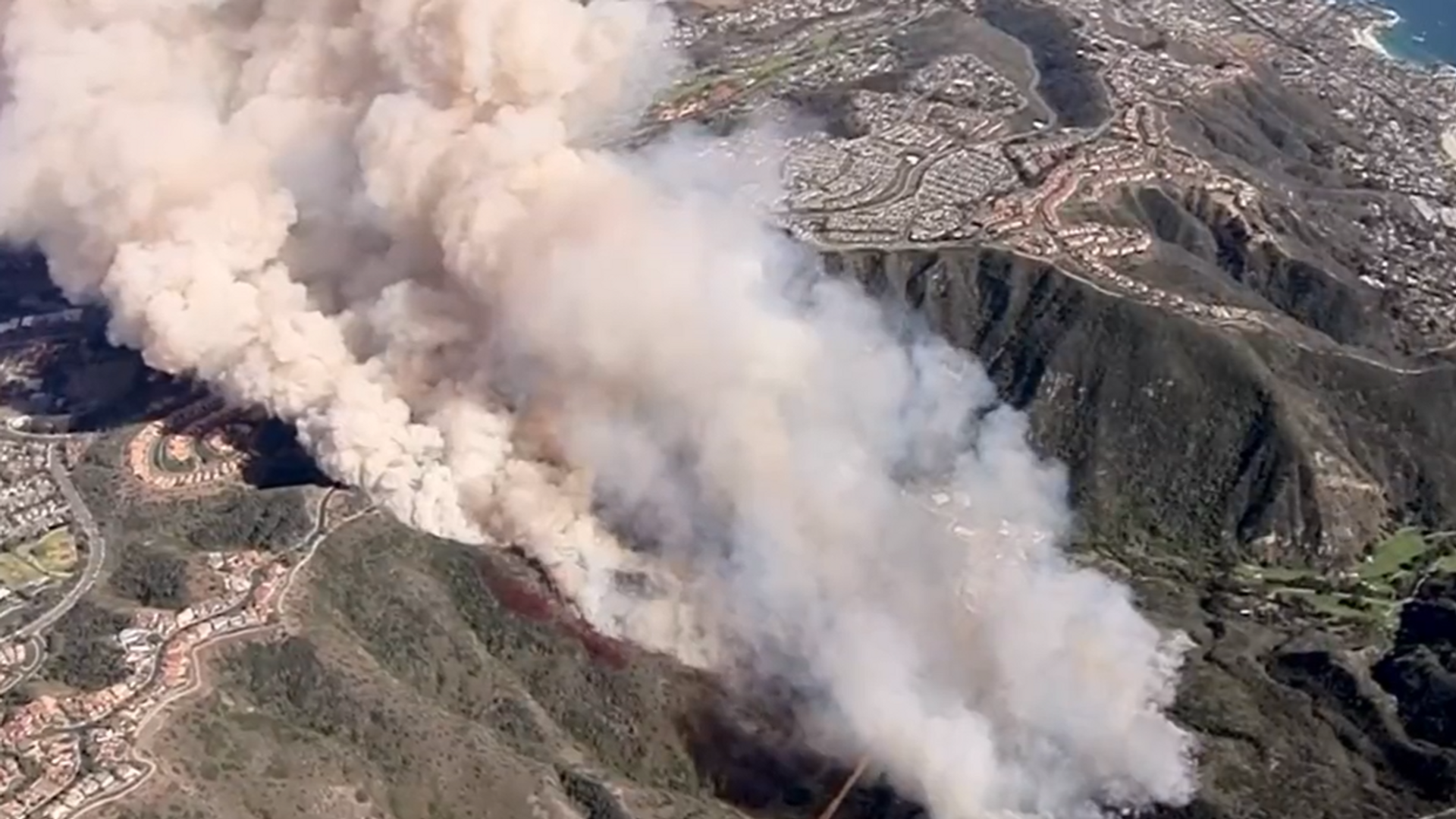https://sputnikglobe.com/20220513/laguna-niguel-fire-under-investigation-as-colorado-and-new-mexico-battle-blazes-amid-megadrought--1095475503.html
Laguna Niguel Fire Under Investigation as Colorado and New Mexico Battle Blazes Amid Megadrought
Laguna Niguel Fire Under Investigation as Colorado and New Mexico Battle Blazes Amid Megadrought
Sputnik International
Laguna Niguel’s brush fire was first reported in Aliso Woods Canyon on Wednesday at 2:44 p.m. local time. That fire then spread to other parts of Laguna... 13.05.2022, Sputnik International
2022-05-13T00:34+0000
2022-05-13T00:34+0000
2022-10-31T19:49+0000
fire
wildfire
megadroughts
california
colorado
new mexico
https://cdn1.img.sputnikglobe.com/img/07e6/05/0c/1095449213_0:35:1242:734_1920x0_80_0_0_2d239904b3515640dc68cb7fa3ddaa96.png
Authorities working to contain California's Laguna Niguel fire were recently forced to double down on their efforts as strong winds and humid conditions provided fuel and helped the blaze expand to more than 200 acres. According to Orange County Fire Authority Assistant Chief of Field Operations TJ McGovern, the growing fire has destroyed at least 20 homes.The Orange County Fire Authority (OCFA) as well as the Laguna Beach Fire Department both hastened to fight the deadly blaze even as it engulfed entire homes. At least one firefighter was injured and subsequently hospitalized, and 900 homes were still under evacuation orders as of Thursday, according to County Fire Authority Assistant Chief of Field Operations TJ McGovern.The fire, which has been dubbed the Coastal Fire, could continue to grow later Thursday due to increasing heat.The cause of the fire remains under investigation, though the primary electricity supply company Southern California Edison (SCE), released a report on Wednesday revealing that electrical “circuit activity” occurred around the same time that the fire began.“Our information reflects circuit activity occurring close in time to the reported time of the fire,” SCE wrote in a report to the California Public Utilities Commission.Despite this foremost hint that electrical issues played a role in the wildfire, Orange County Fire Chief Brian Fennessy noted that climate change is also to blame for enraging the fire.Amid the worst megadrought the US West has experienced in at least 1,200 years, more states are starting to burn. At the same time as the “Coastal Fire” began raging in Laguna Niguel, two fires broke out in Colorado Springs prompting evacuations and burning eight homes.Meanwhile, New Mexico has been dealing with a series of wildfires for more than a month now.Authorities in New Mexico have been working to tackle a monster wildfire raging about 12 miles northwest of Las Vegas in Hermits Peaks and Calf Canyon. The fire has created costs of at least $65 million and has yet to be contained. To date, it is the largest ongoing blaze in the US, having burned more than 259,810 acres as of Thursday morning. The cause of New Mexico’s unstoppable fire is the same as California’s: dry vegetation and gusty winds.“It’s been a nightmare,” Travis Regensberg, a general contractor, told CNN last Thursday. “It’s been really tough for us. I’ve been on this 17 days straight— three, four hours of sleep a night to protect the communities here. This fire is a sleeping beast. I mean, I call it the devil.”Last Thursday, President Joe Biden declared a major disaster in New Mexico, unlocking federal aid that is critically needed for temporary housing and home repairs.“This fire is going to keep growing,” officials said in an update Thursday morning, noting that weather has been unfavorable for “weeks.”The frequency of large wildfires has increased in recent decades. Fires larger than 10,000 acres are now seven times more common than they were in the 1970s. And the West’s megadrought, which is the most extreme megadrought the region has experienced in at least 1,200 years, has only exacerbated the issue.
colorado
new mexico
Sputnik International
feedback@sputniknews.com
+74956456601
MIA „Rossiya Segodnya“
2022
Mary Manley
https://cdn1.img.sputnikglobe.com/img/07e6/01/0b/1092187887_0:0:2048:2049_100x100_80_0_0_0c2cc4c84f89aff034cc55bb01fb6697.jpg
Mary Manley
https://cdn1.img.sputnikglobe.com/img/07e6/01/0b/1092187887_0:0:2048:2049_100x100_80_0_0_0c2cc4c84f89aff034cc55bb01fb6697.jpg
News
en_EN
Sputnik International
feedback@sputniknews.com
+74956456601
MIA „Rossiya Segodnya“
Sputnik International
feedback@sputniknews.com
+74956456601
MIA „Rossiya Segodnya“
Mary Manley
https://cdn1.img.sputnikglobe.com/img/07e6/01/0b/1092187887_0:0:2048:2049_100x100_80_0_0_0c2cc4c84f89aff034cc55bb01fb6697.jpg
fire, wildfire, megadroughts, california, colorado, new mexico
fire, wildfire, megadroughts, california, colorado, new mexico
Laguna Niguel Fire Under Investigation as Colorado and New Mexico Battle Blazes Amid Megadrought
00:34 GMT 13.05.2022 (Updated: 19:49 GMT 31.10.2022) Laguna Niguel’s brush fire was first reported in Aliso Woods Canyon on Wednesday at 2:44 p.m. local time. That fire then spread to other parts of Laguna Niguel, an upscale city in Orange County, California. The coastal city is situated between Los Angeles and San Diego, and boasts multimillion-dollar mansions, wineries, and golf courses.
Authorities working to contain California's
Laguna Niguel fire were recently forced to double down on their efforts as strong winds and humid conditions provided fuel and helped the blaze expand to more than 200 acres.
According to Orange County Fire Authority Assistant Chief of Field Operations TJ McGovern, the growing fire has destroyed at least 20 homes.
The Orange County Fire Authority (OCFA) as well as the Laguna Beach Fire Department both hastened to fight the deadly blaze even as it engulfed entire homes. At least one firefighter was injured and subsequently hospitalized, and 900 homes were still under evacuation orders as of Thursday, according to County Fire Authority Assistant Chief of Field Operations TJ McGovern.
The fire, which has been dubbed the Coastal Fire, could continue to grow later Thursday due to increasing heat.
The cause of the fire remains under investigation, though the primary electricity supply company Southern California Edison (SCE), released a report on Wednesday revealing that electrical “circuit activity” occurred around the same time that the fire began.
“Our information reflects circuit activity occurring close in time to the reported time of the fire,” SCE wrote in a
report to the California Public Utilities Commission.
Despite this foremost hint that electrical issues played a role in the wildfire, Orange County Fire Chief Brian Fennessy noted that climate change is also to blame for enraging the fire.
“These are not Santa Ana winds. These are coastal winds that we experience, generally, every day. The big difference, and we’re seeing it again, is with climate change. The fuel beds in this county, throughout Southern California and throughout the west, are so dry that fire like this is going to be more commonplace,” said Fennessy.
Amid the worst
megadrought the US West has experienced in at least 1,200 years, more states are starting to burn. At the same time as the “Coastal Fire” began raging in Laguna Niguel, two fires broke out in
Colorado Springs prompting evacuations and burning eight homes.
Meanwhile, New Mexico has been dealing with a series of wildfires for more than a month now.
Authorities in New Mexico have been working to tackle a monster wildfire raging about 12 miles northwest of Las Vegas in Hermits Peaks and Calf Canyon. The fire has created costs of at least $65 million and has yet to be contained.
To date, it is the largest ongoing blaze in the US, having burned more than 259,810 acres as of
Thursday morning. The cause of New Mexico’s unstoppable fire is the same as California’s: dry vegetation and gusty winds.
“It’s been a nightmare,” Travis Regensberg, a general contractor, told CNN last
Thursday. “It’s been really tough for us. I’ve been on this 17 days straight— three, four hours of sleep a night to protect the communities here. This fire is a sleeping beast. I mean, I call it the devil.”
Last Thursday, President Joe Biden declared a major disaster in New Mexico, unlocking federal aid that is critically needed for temporary housing and home repairs. “This fire is going to keep growing,”
officials said in an update Thursday morning, noting that weather has been unfavorable for “weeks.”
The frequency of large wildfires has increased in recent decades. Fires larger than 10,000 acres are now seven times more common than they were in the
1970s. And the West’s megadrought, which is the most extreme
megadrought the region has experienced in at least 1,200 years, has only exacerbated the issue.
"We’re already in climate disaster mode across the planet, but in the southwestern United States, there’s no word to describe the danger of not having water," New Mexico state Representative Roger Montoya told
AccuWeather on Wednesday. "For the last 34 days, our communities have been devastated by these fires. They're catastrophic."




